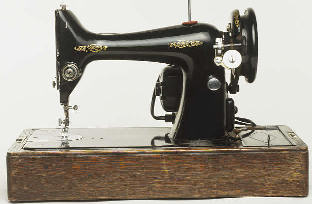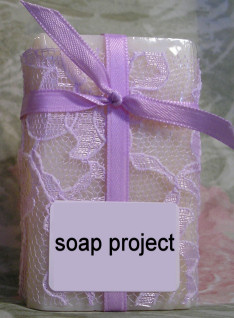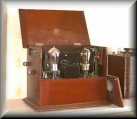Radio Soap (serial drama) - STARTING UP
SCRIPTING & GETTING THE 'SOAP FACTORY' SET UP - PRE-PRODUCTION
THREE PHASES OF PRODUCTION - PRE-PRODUCTION, PRODUCTION, POSTPRODUCTION
TEAMWORK
|
You start script development - script meetings to develop storylines, characters (and their back stories), and the overall structure and design of the soap. |
| You appoint an overall Soap Editor, who has final control - whose decision is final and speedy. (Any creative enterprise has to have a final decision-making structure.) The overall management structure has to be a pyramid. |
| Sometimes the Soap Editor can be appointed anew each day. You can share this management role. |
| You could belong to any or all of the teams. |
|
SOAP BIBLE You communicate rapidly. Decisions can change rapidly. You set up a 'SOAP BIBLE' of the agreed details (storylines, characters, locations, production and postproduction style, etc.). |
| I recommend using an in-production web site, and you all contribute to the 'SOAP BIBLE' and production details. This means that everyone can consult ongoing developments. Use email too. |
| You will set up a marketing web site, which gives the broadcasting information, and sells the soap. |
| Be prepared for rapid changes, especially in the storyline development. Your team could suddenly change a main character or a storyline. |
 BASIC
FOUNDATION DECISIONS FOR THE SOAP ARE CRUCIAL - and that is why
they need a lot of discussion and planning. What is the 'BIG
IDEA'? Where it is set so that the main characters are brought
together? BASIC
FOUNDATION DECISIONS FOR THE SOAP ARE CRUCIAL - and that is why
they need a lot of discussion and planning. What is the 'BIG
IDEA'? Where it is set so that the main characters are brought
together? |
| ALAN BECK'S FORMULA FOR THE MAIN CHARACTERS |
| Types of radio plays (fiction and mixed genres) |
| Storyboard - layout of scenes and details - how to make it work for you |
STUDY THE TECHNIQUES OF RADIO DRAMA PRODUCTION - HERE
Standard production (predominant style in realist radio plays)
'SOAP FACTORY' - FOUR SYSTEMS RUNNING TOGETHER
| Create the soap like a factory - continuous production once you get going - a lot of work building the system. |
| The FIVE SYSTEMS get going continuously and you have to multi-task. |
| (1) PRE-PRODUCTION (script development, scripting, casting and preparing for studio work) |
| (2) PRODUCTION (in the studio and outside the studio - OB) |
| (3) POSTPRODUCTION (and trying soap episodes out with focus group), trails |
|
|
| The SOAP EDITOR has to coordinate all this and keep all FOUR FACTORY SYSTEMS running |
| GET SELLING YOUR SOAP FROM AS EARLY AS POSSIBLE - this is about your future career! |
 HOW
MANY WORDS FOR A 5-MINUTE EPISODE? HOW MANY SCENES?
HOW
MANY WORDS FOR A 5-MINUTE EPISODE? HOW MANY SCENES?
| Development of the main storyline and minor storylines |
| You write the radio announcer's lead-in script for your episode |
| You will contribute specific material to the soap's web site as part of the team. |
| If you use music (underscoring and/or music bridges), you supply logging information (legal requirement for broadcasting). |
| ABOVE ALL, YOU ARE PART OF A TEAM AND YOU COMMUNICATE TOGETHER RAPIDLY AND EFFICIENTLY. |
 SCRIPT
SCRIPT
SCRIPT EXAMPLES OF 5-MINUTE SOAPS (radio serial dramas)
| 'Space Detectives' - radio soap 2002 |
| 'The Canterbury Vampires' - radio soap 2003 - script - 50 episodes |
| 'Wrap Pack' - radio soap 2005 - 25 episodes |
SCRIPTING BASICS - mechanics and radio drama conventions
| Monologues |
| Soap - use of monologues |
Nuts and bolts of scripting and characterisation
 EDITING DIALOGUE
EDITING DIALOGUE 
| IS THAT HOW THOSE CHARACTERS 'REALLY' SPEAK? |
| EXAMPLE - CUT OUT THAT 'AND' AND THAT 'BUT' - chop it up! |
| Swear words - exclamations - profanities (SUBSTITUTES) |
| BBC Editorial Guidelines - links and excerpts |
| INTENSIFYING THE MOMENT |
| A & B information |
| Use labels - get detailed - diamond words |
| Use a thesaurus (book of synonyms) |
Plot - the story - and Alan Beck's formula
| PLOT - get on with it - the BIG SET UP - realism or mixed realism? - types of plays - why not push it on 50 or 100 years into the future? |
| ALAN BECK'S FORMULA FOR THE MAIN CHARACTERS - the 5 'heroes' |
| CONTRAST AND CONFLICT AND 'UST' (unresolved sexual tension) |
| PROTAGONIST |
MAKING SOUND PICTURES
Making sound pictures.
GET OUT OF TV AND FILM - DISCOVER RADIO DRAMA FOR WHAT IT IS.
Scene boundaries: Do you have enough short scenes? Use short
scenes.
Do you need 'we go with' or a separate scene?
DON'T BE TOO NOISY - NO EXPLOSIONS OR GUN SHOT BESIDE THE MICROPHONE.
You have to 'walk on the line'.
Where is the sound centre?
Get your characters doing something - not stand and deliver dialogue.
NARRATOR
TIME SCENARIO - THERE IS NO RULE YOU MUST GO FROM BEGINNING TO END
| Scripting team. |
| Soap director - you direct and post-produce your episodes. |
| Soap producer - the business side - auditioning (see Radio Spotlight Book below) and casting and organising the actors and production, and all the business aspects of the soap. |
| Auditions - you set up auditions - publicity and the business side - as early as possible. |
|
Team work As soap directors and producers, you divide up the tasks between yourselves and ensure that they are carried out. This must be done in a business-like way - as an Independent Production Company. |
|
Drop-in script - you script the introduction that the programme presenter is to give for each episode when it is broadcast. This will go on the web site. If you are marketing this soap to a range of radio stations, the information is immediately available there for the presenter. |
| You launch the soap - marketing. |
|
You build the web site. See 'The Canterbury Vampires' web site as an example (2002-3). Also 'Space Detectives Are Go!' (2001-2). |
| You market the soap for broadcast. This is also part of your work as a producer. |
| You log all the copyright material for each episode. |
|
You have to consider the legal aspects of the soap - the legal statement on the web site, copyright, taste and decency issues (including swearing), how what the BBC calls PRODUCER GUIDELINES affects plot and dialogue. You have to have a management structure to deal with this, through the Editor, and from the beginning in scripting. |
|
SOAP EDITOR Each scene script must be signed off by the Editor before it can go to production. Redrafting may be required - so get used to it! Each scene has to be signed off by the Editor after production. The Editor may demand changes or scrapping it and doing it anew. Each episode is signed off by the Editor. |
|
Focus group meeting You arrange a test of two episodes (for example) for a focus group. You invite a range of listeners and play them the episodes. You take notes of their discussion and responses. You give them an evaluation form to fill in. You thank them! You do this early on in production for the first time. You may wish to do a lot more focus group meeting work if you are producing an 'issues' soap. |
Note:
'Clump' means the group of five or more or less episodes that make up a week. (You may be broadcasting Monday through to Friday (= five episodes), or less or more.)
Each weekly clump has a working name (as 'Valentine', 'Planet Talent', 'Rag Week' - titles from Alan Beck's previous soaps.)
The working name helps us all refer to the clump speedily and to place it overall in the scheme.
Numbering:
Each clump has a number, and each episode has a number, and each scene has a number.
So the first episode of the whole soap is 1.1.1 = Clump 1, Episode 1 (of 5) of that clump, and Scene 1 of that episode. This numbering system is so essential! It avoids confusion, and it gives an immediate signal where that scene is in the whole scheme.
Making a soap is like building and running a factory.
We go to a lot of time and trouble designing and building the factory (script development, character development, plot and research), and then we get the factory running. The aim is to be efficient!
|
Editor - with absolute decision-making rights over all aspects of the soap. Examples - script drafting, production, post-production. This means that if the Editor requires a scene to be redone (production or post-production), then it has to be redone. This is a tough rule! The Editor is the final judge of questions of taste and decency, referable words, diversity, music, entertainment values, subject matter, plot, etc. |
|
Designing the soap |
|
As this is for broadcast, the soap must comply with BBC Producers' Guidelines There are issues of taste and decency. |
|
Scripting - What Genre? |
|
Music choices: Aim is to use entertaining and ironic music choices - usually as music bridges (between scenes) and as underscoring music. The latter to add to the texture of the scene, mood, and sound picture (aural 'mise en scène'). |
|
|
| Balancing the scenes in the episode overall - creative design. |
| Setting up the web site |
|
CASTING Students have total responsibility for this. Teacher can intervene as Soap Editor to require changes. But responsibility for below average acting remains with radio students. It is your duty as producers to go out and find good enough actors. You have to go to performances, ask around, network, ask student directors etc. You have to do the hard work of finding the best actors. You are marked on the quality of the acting in your episodes. CLUSTERING A key problem - characters' voices which are too alike and sound the same. This is a particular problem in radio drama. To be avoided at all costs! |
Various techniques
|
Monologues The listeners do not expect them, they break the realism convention of dialogue, and they become clumsy too quickly. But there are some special circumstances where a short monologue is to be used .... a character distracted or worried and speaking aloud, as in real life it is to be expected. |
|
ESTABLISH OUTSIDE SCENE Otherwise you run the danger that the scene sounds like a studio-bound scene and not in outside location. The production and post-production work has to be done here to establish the sound picture outside. There also has to be key elements in the script - especially description and signposting. |
|
ESTABLISH SOUND CENTRE AT THE TOP OF A SCENE This establishes a measure for all the other characters. We are 'with' or nearest the first character speaking. That helps us get the perspective of the sound picture in our 'view' as listeners. |
|
Make use of an effective 'close-up' - near the end of a scene, you could bring your two characters (best with two) nearer the microphone - into position number 2, and so the last phrase of the dialogue is intimate - closer to the audience, and a 'close-up' shot. You can even bring the characters (best with two) into position number 2 for longer, and place them further away again, at position number 3. |
|
Time-space rule: In going to the following scene, this rule has to be observed. The same character or characters cannot be in another location in the immediately following scene. You cannot have a leap forward in time and space through a scene boundary. This is a difficulty for scripting. The solution is to have a small scene in between, and often to slice another scene into two. And use part as an insert. It is stylish to divide a scene so - often!
You might find - rarely - that it is broken in a radio play, or very rarely in 'The Archers'. But those exceptions are for the professionals. We have to stick to the 'time-space rule'. There are some exceptions:
But do not make this obviously so at the top of the scene. Do not puzzle your listener. For example, a vampire can express the intention of meeting a human in one scene. That vampire will be in the following scene. But begin that following scene with the human first, and then with the vampire arriving to confront. It gives just a little time for the vampire to travel.
Almost a rapid montage ... we cut from one to another, or we are in the cops' car, and then crossfade with a small leap forward in time, in the same cops' car, and we are that little ahead in time in the exciting chase. Make sense of this by genre (that is what is done in film and on TV), and by description).
(c) Very exceptional circumstances You can break the time-space rule for a human character in very exceptional circumstances. You must seek advice from teacher. Even so, a music bridge covers the sin! But there must be a very particular plot reason for this - for this leap forward in time and place.
(d) A leap in time - and NOT in place You have permission - with a suitable scene boundary (music bridge or fading up and then down some FX relating to the location or activity) - to script the character in a scene and then in the following scene and there is a leap in time, but NOT in the location. Your character is in the same location - we have just moved forward in time for a particular plot reason. |
|
Getting the scene boundaries right (with music) |
|
Linking Scenes This is a crucial technique and very much part of your overall creative approach to the whole episode. You cannot go to silence between each scene, and you cannot use a music bridge between each scene. You have to vary the means to suit the creative construction of the whole episode, and the pace. You have to develop a feel for the listener and the pace of the action through the episode. If you have an exciting scene, then after it, it is a good idea to have a quiet scene, in a neutral acoustic, or a quiet acoustic. Here are the techniques for linking scenes: (1) 'Archers fade' (2) Music bridge (3) Crossfade (4) Fade down scene and straight cut into following scene ('hard into') (5) Straight cut scene and fade into following scene ('soft into') (6) 'Lightning cut' |
|
Signposting and establishing location |
|
Balancing the atmos against the dialogue Students have difficulty with this. You have to listen to radio plays, and gain experience. |
|
Choice of background atmos: (1) (2) An atmos with sharp peaky noises in it - USE WITH CAUTION - BUT DEFINITELY USE THIS. Examples are a wood fire (with crackling flames), and (in 'The Canterbury Vampires'), in the chemistry lab, the bubbling of a test tube. This very distinctive atmos is really worth it for establishing the scene at the top - signposting. But the problem is that the sharp little peaky sounds can become annoying to the listener. The bubbling in the chemistry lab is a good example. |
|
RULE - BACKGROUND ATMOS: (1) Bring in and establish as signposting. (2) Fade under dialogue, but not out - so that it is still present. (3) Balance the atmos against the dialogue - not easy to do. Listen carefully to examples from broadcast radio plays. (4) Bring up or 'tease up' the atmos a little - up a little from its usual level against the dialogue - and then down to the previous level. This nudges it into the listener's attention. There is a LAW OF DIMINISHING RETURNS about the background atmos. After a shortish while, the listener will cancel it out, and disregard it. That is the ear-to-brain mechanism. |
|
DAY RULE: Each episode takes place on a different day - Monday to Friday. You cannot disobey this and you have to plan this from the beginning with your scripting of the story lines. It is sometimes difficult - as you plan an exciting stretch of action, and it cannot (in draft) be fitted into one episode. But the rule must be obeyed. The same applies to 'The Archers' - we live the lives of the characters from day to day. This not only creates a 'real time' feeling to the ongoing soap, but it is a very useful way of organising a lot of plot. ONLY ONE EXCEPTION TO THE 'DAY RULE': Between Thursday and Friday - building to a big plot explosion at the end - you can end Thursday late at night and into the early hours of Friday, and then take up Friday's action from there. |
|
How many plots exist out there? Look at http://www.straightdope.com/columns/001124.html |
|
See INDEX 'A' TO 'Z' (RADIO SOAP SITE) See also 'Radio Drama - directing, acting, technical, learning & teaching, researching, styles, genres'. See INDEX to navigate also. Complete curriculum of scripts, techniques (acting & directing & post-production & genre styles), advice, sound files - effects and atmoses (with no copyright and so free to use), detailed script commentaries, etc. Academic material on this site is Learn about radio drama on this site along with my book - Beck, Alan, Radio Acting, London: A & C Black ISBN 0-7136-4631-4 Available on Amazon. CLICK HERE. To the WELCOME PAGE for Alan Beck's sites. See more of Alan Beck's work.
Any opinions expressed in this site are the personal opinions of the owner of the site. IF YOU HAVE COMMENTS, PLEASE EMAIL TO : [email protected] |






